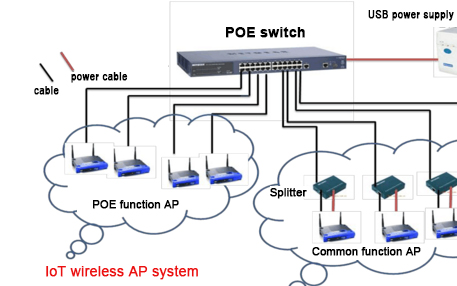1.Overview
The Internet of Things equips sensors to various real objects such as power grids, railways, bridges, tunnels, highways, buildings, water supply systems, dams, oil and gas pipelines, and household appliances, and connect them through the Internet, and then run specific programs to achieve remote control Or to achieve direct communication between things. Through the Internet of Things, a central computer can be used to centrally manage and control machines, equipment, and personnel, as well as remote control of home equipment and cars, as well as various applications such as finding locations and preventing items from being stolen. In many of the above applications, there is no lack of a power supply technology, and POE (POwerOverEthernet) is a technology that can transmit power and data to the device through a twisted pair in the Ethernet. Through this technology, including Internet phones, wireless base stations, network cameras, hubs, smart terminals, modern smart office equipment, computers, etc., POE technology can be used to supply power to complete the operation of various equipment. The electronic equipment powered by the network can be used without additional power sockets, so at the same time it can save the time and money for configuring the power cord, so that the cost of the entire device system is relatively reduced. With the widespread application of Ethernet, RJ-45 network sockets are widely used in the world, so all kinds of POE devices are compatible. POE does not need to change the cable structure of the Ethernet circuit to operate, so the use of the POE system not only saves costs, is easy to wire and install, but also has the ability to power on and off remotely.
2.The main application of POE in the Internet of Things
With the development of technology and applications, the connotation of the Internet of Things continues to expand, and new understandings have emerged-the Internet of Things is the expansion application and network extension of the communication network and the Internet. It uses perception technology and smart devices to perceive and recognize the physical world. Network transmission and interconnection, calculation, processing and knowledge mining, realize the information interaction and seamless connection between people and things, and things and things, and achieve the purpose of real-time control, precise management and scientific decision-making of the physical world. Therefore, the network will no longer passively meet the needs of users, but will actively perceive changes in user scenarios, conduct information interaction, and provide users with personalized services.
The impact of wireless network technology on people is indisputable. The application range of wireless local area network is becoming wider and wider, in large offices, smart warehouses, university campuses, shopping malls, airports, convention and exhibition centers, hotels, airports, hospitals, etc. Bars, coffee shops, etc. realize the needs of people to surf the Internet anytime, anywhere. In the process of deploying a wireless network, the most important task is the reasonable and effective installation of the wireless AP (AccessPOint). The TG cloud platform can provide a complete set of management in a centralized, reasonable and effective manner. In larger wireless network coverage projects, there are a large number of wireless APs and they are distributed in various parts of the building. Generally, APs need network cables to connect to switches and external connections. DC power supply. Solving power and management on the spot will greatly increase the cost of construction and maintenance. The “UNIP” power supply switch solves the problem of centralized power supply of wireless APs through network cable power supply (POE), which can greatly solve the problems of local power supply encountered during project construction and future AP management problems. This prevents individual APs from failing to function properly during partial power outages. In this solution, it is necessary to use AP equipment that supports 802.3af/802.3af protocol functions to achieve the function of network cable power supply. If the AP does not support the 802.3af/802.3af protocol function, you can directly install the data and POE synthesizer to complete this power supply function. As shown in Figure 1:
3. The application of POE smart terminals in the Internet of Things
When making a call at home, if there is a sudden power failure, the call will not be interrupted. This is because the power supply of the telephone terminal is directly supplied by the telephone company (central office) switch through the telephone line. Imagine that if the industrial field sensors, controllers and smart terminal actuators in the Internet of Things can also be directly powered by Ethernet for modern office equipment, then the entire wiring, power supply, labor and other costs may be reduced a lot, and Extending monitoring to many remote applications, this is a vision portrayed by POE technology to the industrial control community of the Internet of Things. In 2003 and 2009, the IEEE approved the 802.3af and 802.3at standards respectively, which clearly stipulated the power detection and control items in the remote system, and used Ethernet cables for routers, switches, and hubs to communicate with IP phones, security systems, and wireless The power supply method for devices such as LAN access points is regulated. The release of IEEE802.3af and IEEE802.3at has greatly promoted the development and application of POE technology.






